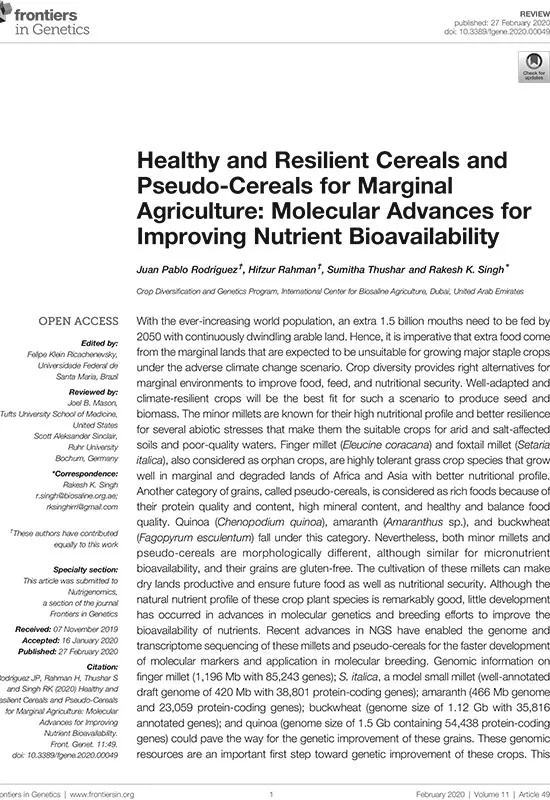Healthy and Resilient Cereals and Pseudo-Cereals for Marginal Agriculture: Molecular Advances for Improving Nutrient Bioavailability
With the ever-increasing world population, an extra 1.5 billion mouths need to be fed by 2050 with continuously dwindling arable land. Hence, it is imperative that extra food come from the marginal lands that are expected to be unsuitable for growing major staple crops under the adverse climate change scenario. Crop diversity provides right alternatives for marginal environments to improve food, feed, and nutritional security. Well-adapted and climate-resilient crops will be the best fit for such a scenario to produce seed and biomass. The minor millets are known for their high nutritional profile and better resilience for several abiotic stresses that make them the suitable crops for arid and salt-affected soils and poor-quality waters. Finger millet (Eleucine coracana) and foxtail millet (Setaria italica), also considered as orphan crops, are highly tolerant grass crop species that grow well in marginal and degraded lands of Africa and Asia with better nutritional profile.
Another category of grains, called pseudo-cereals, is considered as rich foods because of their protein quality and content, high mineral content, and healthy and balance food quality. Quinoa (Chenopodium quinoa), amaranth (Amaranthus sp.), and buckwheat (Fagopyrum esculentum) fall under this category. Nevertheless, both minor millets and pseudo-cereals are morphologically different, although similar for micronutrient bioavailability, and their grains are gluten-free. The cultivation of these millets can make drylands productive and ensure future food as well as nutritional security. Although the natural nutrient profile of these crop plant species is remarkably good, little development has occurred in advances in molecular genetics and breeding efforts to improve the bioavailability of nutrients. Recent advances in NGS have enabled the genome and transcriptome sequencing of these millets and pseudo-cereals for the faster development of molecular markers and application in molecular breeding. Genomic information on finger millet (1,196 Mb with 85,243 genes); S. italica, a model small millet (well-annotated draft genome of 420 Mb with 38,801 protein-coding genes); amaranth (466 Mb genome and 23,059 protein-coding genes); buckwheat (genome size of 1.12 Gb with 35,816 annotated genes); and quinoa (genome size of 1.5 Gb containing 54,438 protein-coding genes) could pave the way for the genetic improvement of these grains. These genomic resources are an important first step toward genetic improvement of these crops. This review highlights the current advances and available resources on genomics to improve nutrient bioavailability in these five suitable crops for the sustained healthy livelihood.
Year
2020
Publication Source
Frontiers in Genetics
Publication type
Scientific Paper
Volume/Chapter/Issue
11











